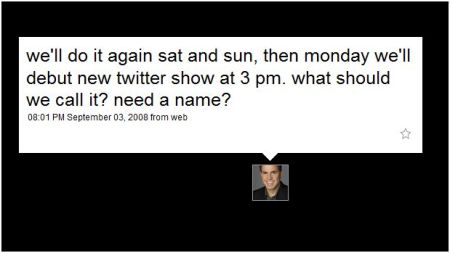Well, Rick Sanchez Direct was unloosed this afternoon onto an unsuspecting world. The CNN program appears to be the first head-on, full-frontal attempt by a mainstream media organization to harness the social web, live and on the air, to report the news.
Promoted on Sanchez’s own Twitter feed as a “Twitter show,” the production turned out to be more like a FriendFeed Gone Wild.
While Sanchez presented the news of the day, he harvested real-time viewer comments streaming in via Twitter, Facebook and MySpace [what, dude, you’re like 15?]. Raw news came in via cell phone images, mobile phone calls and user-generated video. There was even a multi-culti touch, with a flamboyantly Spanish speaking correspondent from CNN Espanol.
Sanchez is full of himself as a broadcaster and 2.0h geek–a brunette Anderson Cooper with ADD and thousands of online friends. His patter was peppered with references to the whiz-bangery by which he was presenting things: “…here’s something from Twitter coming in now, just seconds ago…this is an interactive news broadcast, it’s your show…and this, from Facebook…tell us what you think, we want to hear from you….”
Sanchez clearly relished his role as info-hero, manfully maintaining control of the real-time news battlefield while taking incoming data from all sides. At the end of the broadcast he thanked people for their “openness to Twitter, Facebook”–and indeed, one suspects, to human interaction itself. It was that kind of performance.
It’s easy to ridicule Rick Sanchez Direct as hyperspeed slapdash news-spatter. But truth told I found myself sort of liking it–the hour went fast, I got quick licks of the headlines-of-the-day, and heard the [alas, predictable] voices of my fellow Americans chattering about it all. There are worse news shows, and many that are more boring.
Which is not to say RSD is substantial or of great public value. But let’s consider the context before we bemoan the shameful intellectual decay of cable news–the domain of Wolf Blitzer, Sean Hannity and those blonde women on Fox–wrought by Twitter and Facebook.
Network TV news as it is widely practiced is highly mannered, with carefully staged standups, scripted stories, well-spoken talking heads and press conference snippets, all presented with assertive declamations by people who, as they say outside major media markets, clean up real good.
The thought that this somehow constitutes “news” in its pure form is ridiculous.
The thought that adding social media to the mix could wreck it is fatuous.
News is stuff that happens that someone finds interesting. There are infinite ways to present it. As the culture changes, so does the way it’s delivered.
My biggest complaint with RSD is that the need to generate a constant stream of real-time apoplexy to fill that Twitter screen, Sanchez & Co. will have to keep baiting the hook with red meat.
In today’s Episode One, the topics included “hard to watch” cell phone video of dead civilians in Afghanistan, a bunch of loony pastors who plan to take “all the way to the Supreme Court if necessary” their God-given right to endorse Republic–er, various candidates for public office, user videos of ginormous waves crushing the coastline of Cuba, the Government Bailout of Freddie and Fannie with Your Tax Dollars, etc.
And through Twitter and Facebook and god help us MySpace the people expressed their shock and disgust and dismay!
Sure, this is phony populism–“the issues that America really cares about,” overheated for the purposes of sensation. But welcome to our century. Later in the day, World News Tonight, Fox News and even NPR covered the very same stories, but without the public feedback.
As they say in the eye doctor’s office: Worse? Or better?
Is Rick Sanchez Direct a smart move for CNN? The 3 p.m. weekday time slot isn’t particularly valuable broadcast real estate. Why not turn it into a faddish, hyperkinetic, multi-screen, multi-media playground and see what happens?
Besides, think of the sponsorship opportunities.
For CNN sales reps, I have just two words: Red Bull.
* * * *
For more, see my previous entry previewing the program.






















Recent Comments